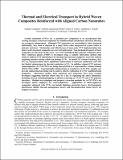| dc.contributor.author | Yamamoto, Namiko | |
| dc.contributor.author | Guzman de Villoria, Roberto | |
| dc.contributor.author | Cebeci, Hulya Geyik | |
| dc.contributor.author | Wardle, Brian L. | |
| dc.date.accessioned | 2012-09-07T18:00:29Z | |
| dc.date.available | 2012-09-07T18:00:29Z | |
| dc.date.issued | 2010-04 | |
| dc.identifier.isbn | 9781617386138 | |
| dc.identifier.isbn | 1617386138 | |
| dc.identifier.uri | http://hdl.handle.net/1721.1/72572 | |
| dc.description.abstract | Carbon nanotubes (CNTs) are a potential new component to be incorporated into
existing aerospace structural composites for multifunctional (mechanical, electrical, thermal,
etc.) property enhancement. Although CNT properties are extraordinary when measured
individually, they tend to degrade by a large factor when integrated in system (often in
polymer matrices). Mechanisms and effectiveness of nano-scale CNT implementation into
macro-scale structural composites are not well understood. Non-mechanical aspects of these
composites are the focus of this work. As a CNT hybridized fiber polymer composite, fuzzy
fiber reinforced plastic (FFRP) is developed using a scalable fabrication method that
achieves uniform CNT distributions for thermal and electrical conductive networks without
requiring intensive mixing which can damage CNTs. At small CNT volume fractions (~0.5-
8% Vf), characterization shows significant enhancement in electrical conduction (x106-108)
but limited enhancement in thermal conduction (x1.9). In addition, aligned-CNT polymer
nanocomposites (A-CNT-PNCs) are being characterized as a representative volume element
(RVE) of the FFRP. Experimentally obtained data on consistent A-CNT-PNC samples sets
provide engineering knowledge and to achieve effective utilization of CNTs' multifunctional
properties. Theoretical studies, both analytical and numerical, have been recently
developed, suggesting interface effects may be a key to explaining the above limitations,
including electron tunneling/hopping or phonon scattering at CNT-CNT and CNT-polymer
interfaces. Multiple test techniques and property extraction methods for A-CNT-PNCs are
developed and/or employed for cross-comparison. Applications of nano-engineered
composites enhanced with CNTs can include lightning protection layers, electromagnetic
interference shields, thermal management layers, and thermoelectrical sensor layers for
airplane structures. | en_US |
| dc.description.sponsorship | Airbus Industrie | en_US |
| dc.description.sponsorship | Massachusetts Institute of Technology (Richard and Linda Hardy Graduate Fellowship) | en_US |
| dc.description.sponsorship | Boeing Company | en_US |
| dc.description.sponsorship | Empresa Brasileira de Aeronáutica | en_US |
| dc.description.sponsorship | Lockheed Martin | en_US |
| dc.description.sponsorship | Spirit AeroSystems (Firm) | en_US |
| dc.description.sponsorship | Textron, inc. | en_US |
| dc.description.sponsorship | Composite Systems Technology (Firm) | en_US |
| dc.description.sponsorship | Toho Tenax Co., Ltd. | en_US |
| dc.description.sponsorship | Massachusetts Institute of Technology (Nano-Engineered Composite aerospace STructures (NECST) Consortium) | en_US |
| dc.language.iso | en_US | |
| dc.publisher | American Institute of Aeronautics and Astronautics | en_US |
| dc.rights | Creative Commons Attribution-Noncommercial-Share Alike 3.0 | en_US |
| dc.rights.uri | http://creativecommons.org/licenses/by-nc-sa/3.0/ | en_US |
| dc.source | Wardle (via assistant) | en_US |
| dc.title | Thermal and Electrical Transport in Hybrid Woven Composites Reinforced with Aligned Carbon Nanotubes | en_US |
| dc.type | Article | en_US |
| dc.identifier.citation | Yamamoto, Namikonet al. "Thermal and Electrical Transport in Hybrid Woven Composites Reinforced with Aligned Carbon Nanotubes." in Proceedings of the 51st AIAA/ASME/ASCE/AHS/ASC Structures, Structural Dynamics and Materials Conference, 2010, 12-15 April 2010, Orlando, Florida, USA, American Institute for Aeronautics and Astronautics (AIAA. | en_US |
| dc.contributor.department | Massachusetts Institute of Technology. Department of Aeronautics and Astronautics | en_US |
| dc.contributor.department | Massachusetts Institute of Technology. Department of Materials Science and Engineering | en_US |
| dc.contributor.approver | Wardle, Brian L. | |
| dc.contributor.mitauthor | Yamamoto, Namiko | |
| dc.contributor.mitauthor | Guzman de Villoria, Roberto | |
| dc.contributor.mitauthor | Cebeci, Hulya Geyik | |
| dc.contributor.mitauthor | Wardle, Brian L. | |
| dc.relation.journal | Proceedings of the 51st AIAA/ASME/ASCE/AHS/ASC Structures, Structural Dynamics and Materials Conference, 2010. | en_US |
| dc.eprint.version | Author's final manuscript | en_US |
| dc.type.uri | http://purl.org/eprint/type/ConferencePaper | en_US |
| dc.identifier.orcid | https://orcid.org/0000-0003-3530-5819 | |
| mit.license | OPEN_ACCESS_POLICY | en_US |
| mit.metadata.status | Complete | |
